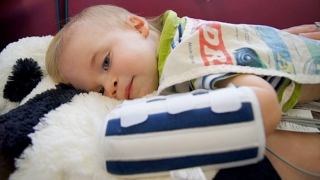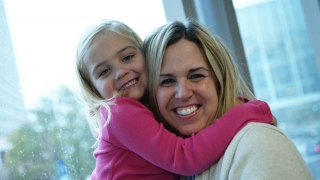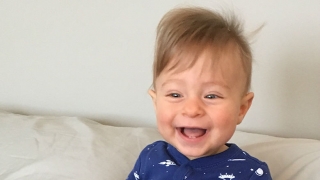Oliver Rutberg’s 1-year-old body was trying to tell him something, and it took The Children’s Hospital of Philadelphia to decipher the code.
For weeks, Oliver had been throwing up several times a night. His parents, Matthew and Shannon, took him to his pediatrician, who suspected a food allergy or gastrointestinal problems but couldn’t find the cause.
 So instead of going to the New Jersey shore as planned for Labor Day weekend, the Rutbergs came to the CHOP Emergency Department. “We said, ‘Let’s just go to CHOP,’” Matthew says. “It’s the best, and it’s in our backyard.”
So instead of going to the New Jersey shore as planned for Labor Day weekend, the Rutbergs came to the CHOP Emergency Department. “We said, ‘Let’s just go to CHOP,’” Matthew says. “It’s the best, and it’s in our backyard.”
The diagnosis: supraventricular tachycardia
Within minutes of arriving at CHOP, they had a diagnosis: supraventricular tachycardia (SVT), a cardiac condition characterized by a racing heartbeat caused by electrical misfiring in the heart. Oliver’s heart was beating 280 times a minute; a normal heart rate is 80 to 200 beats a minute.
SVT is the most common heart rhythm problem found in children, occurring in 1 in 250 to 1,000 children. It tends to occur during times of intense growth, most commonly during the first year, but also from 5 to 7 years of age or during adolescence. SVT occurs, in most cases, because extra electrical pathways, called accessory pathways, form during heart development in utero and persist, resulting in a short circuit that causes the fast heart rates.
Some babies or children with SVT have brief episodes of rapid heartbeat (arrhythmia). Oliver’s heart was in arrhythmia almost constantly. The cycle can be broken by “vagal maneuvers,” as non-medication techniques are called, such as asking the child to cough or hold his breath and “bear down.”
By throwing up, Oliver’s body was trying, unsuccessfully, to accomplish the same thing. The ED doctors tried another vagal maneuver, when they held a bag of ice to Oliver’s face in an attempt to trigger the “diving reflex,” a natural heart slowing function, and break the rapid heartbeat. It didn’t work either.
Expert treatment for arrhythmias in children
Cardiologist Victoria Vetter, MD, MPH, nationally recognized for her expertise in cardiac arrhythmias in children, was on-call that weekend and was in the ED when the Rutbergs arrived. She immediately ordered medicine to halt the arrhythmia. That day, Oliver became a patient of the Cardiac Center at CHOP, and Dr. Vetter became Oliver’s pediatric cardiologist. She worked to find the right combination of medication to keep Oliver’s SVT in check.
It took three weeks in the Cardiac Care Unit, with a short stint in the Evelyn and Daniel M. Tabas Cardiac Intensive Care Unit, before Oliver could return home. He needed to go 36 hours without an episode to be released.
“We had four or five false starts, but as we got near discharge, it would start up again,” Matthew says.
It took the right combination of Amiodarone and Flecainide in the right doses to keep Oliver’s arrhythmias at bay.
“He had a very persistent type and needed a combination of medications,” Vetter says. Every step of the way, Dr. Vetter and Oliver’s entire medical team kept Shannon and Matthew in the loop.
A care team like no other
“We definitely felt like we were a part of Oliver’s care team,” says Matthew. “Being included in the daily rounds was a strong point. There were all these brilliant people in the room, but they were very humble. They didn’t make you feel like you were at a lower level if you didn’t understand something. They made sure we were there when they discussed that day’s care plan. They asked us for our input and respected our knowledge.”
About 75 percent of babies who have SVT will outgrow it by the time they are 1 to 2 years old. In many children, as the heart grows, the accessory electrical pathway is pulled apart.
If Oliver is among the other 25 percent, the next step, when he is much older, would be a catheter ablation procedure to permanently eliminate SVT. During ablation, catheters (thin tubes) are advanced through the main blood vessels in the legs into the heart. Electrical signals from the catheters help locate the extra electrical connection, which can then be destroyed, eliminating the SVT. Ablation is usually an outpatient procedure, and children can go home the same day.
“I would only trust CHOP, if Oliver needs an ablation,” Shannon says.
Trust in CHOP was built over the Rutbergs' inpatient stay last fall. Matthew also recalls the small things that made the family’s inpatient stay special.
“I remember every time there was a nursing shift change, the out-going nurse would introduce us to the next shift nurse,” he says. “Their attention to safety was evident. They washed their hands every time they came in or left the room. I could see them checking Oliver’s ID band, even in the middle of the night, before they gave him his meds.”
He remembers one night, when overnight nurse Jackie Brown, BSN, RN, after taking Oliver’s vital signs, stayed and sang softly to him until he fell back to sleep.
“You see all the accolades about CHOP being the No. 1 children’s hospital,” Matthew says, “but the tenderness our nurse showed that night is the reason CHOP is No. 1 for us.”
A busy 2-year old back at home
Oliver hasn’t had to be hospitalized since last fall. He takes medication five times a day, and is as busy as any 2-year-old — climbing on anything and everything, playing with his dog Calhoun and singing.
Every three months, he sees Dr. Vetter and wears a Holter monitor for 24 hours, which records his heart rate to make sure he isn’t going into arrhythmia. As Oliver continues to grow, Dr. Vetter and the Cardiac Center at CHOP will be there to provide the expert cardiac care he needs.
Originally posted: May 2012




